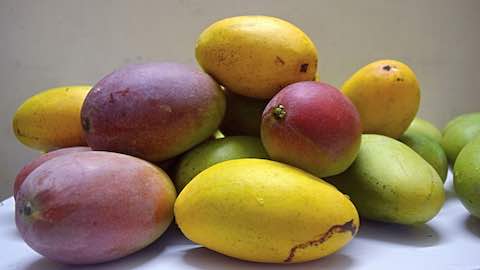- MENU
- HOME
- SEARCH
- WORLD
- MAIN
- AFRICA
- ASIA
- BALKANS
- EUROPE
- LATIN AMERICA
- MIDDLE EAST
- United Kingdom
- United States
- Argentina
- Australia
- Austria
- Benelux
- Brazil
- Canada
- China
- France
- Germany
- Greece
- Hungary
- India
- Indonesia
- Ireland
- Israel
- Italy
- Japan
- Korea
- Mexico
- New Zealand
- Pakistan
- Philippines
- Poland
- Russia
- South Africa
- Spain
- Taiwan
- Turkey
- USA
- BUSINESS
- WEALTH
- STOCKS
- TECH
- HEALTH
- LIFESTYLE
- ENTERTAINMENT
- SPORTS
- RSS
- iHaveNet.com: Mangoes

Much (Well Deserved) Ado About Mangoes
By Sharon Palmer, R.D.
The most popular fresh fruit on the planet, the mango originated in South Asia, where it was once revered as sacred. Every part of the mango tree and its fruit has been used in folk remedies there.
It may surprise you to learn that the mango (Mangifera indica) is in the same family as cashews and pistachios. The sweet, yellow-orange flesh of a mango is packed with a powerful cocktail of 20 different health-protective nutrients. A one-cup serving of sliced mango is an excellent source of vitamins A and C plus 3 grams of fiber. In addition, mangoes provide a variety of antioxidant carotenoids like alpha-carotene, beta-carotene and beta-cryptoxanthin, which lend mangoes the sunny color of their flesh.
Scientists have studied cancer-protective phytonutrients in mangoes and found that, compared to eight other tropical fruits, ripe mangoes contain the highest amount of total polyphenols. Researchers recently analyzed mango juice and juice extract and discovered that certain compounds demonstrate antioxidant activity, cancer growth-halting activity and cancer antipromotion activity. Meanwhile, Australian scientists have found that other mango compounds -- quercetin and norathyriol -- can alter "transcription factors" that might otherwise switch on genes that affect whether specific diseases develop.
A ripe mango can be orange, yellow, red or green, but should be slightly soft to the touch and fragrant. Soften mangoes further in a paper bag at room temperature. Mangoes are delicious alone or paired with other foods. What other fruit can cozy up to salty and spicy foods, seafood dishes, robust red meats, salads and desserts quite as well as sweet, exotic mango does?
If you've never peeled a mango, don't be intimidated by its large flattened oblong pit. Here's one method: Peel the skin with a vegetable peeler, then cut a slice off the bottom so it stands up. Stick a corn holder in the top to hold it while you slice the flesh off. Or use a mango slicer.
Note: People who are allergic to cashews or natural rubber latex can suffer a potentially serious "cross-reactivity" from eating mango due to similar antigens in the plants. And the skin of a mango can induce a rash in people who are especially sensitive to poison ivy. The flesh is safe for them to eat, so they just need to ask someone else to take on mango-peeling duties.
Notable Mango Nutrients
(1 cup sliced mango, about half a medium mango)
Calories: 107
Vitamin A: 1,262 International Units (25 percent DV)
Vitamin C: 46 milligrams (77 percent DV)
Vitamin K: 6.9 micrograms (9 percent DV)
Potassium: 257 milligrams (7 percent DV)
Alpha-carotene: 28 micrograms
Beta-carotene: 734 micrograms
Beta-cryptoxanthin: 18 micrograms
Fiber: 3 grams
DV = Daily Value
Jerk Chicken with Spicy Mango Topper
Recipe courtesy of the National Mango Board.
Makes 4 servings.
2 ripe mangoes, peeled, pitted and diced
1/4 cup lime juice
2 tablespoons brown sugar
1/2 teaspoon crushed red pepper
1/4 teaspoon garlic powder
1/4 teaspoon cinnamon
1/4 teaspoon ground allspice
4 boneless, skinless chicken breasts (about 1 1/2 pounds), flattened slightly
2 tablespoons Jamaican jerk seasoning
1 lime, halved
1. Stir together mango, lime juice, brown sugar, red pepper and spices in a medium bowl; set aside.
2. Sprinkle both sides of chicken with jerk seasoning; let stand for 10 minutes.
3. Cook chicken on a well-oiled grill over medium heat for about 5 to 7 minutes on each side or until cooked through.
4. Remove chicken from grill and squeeze lime halves over chicken. Serve with mango topping.
Nutrition Information Per Serving: 289 calories, 40 grams protein, 3 grams fat, 27 grams carbohydrate, 939 International Units vitamin A, 35 milligrams vitamin C, 548 milligrams potassium, 188 milligrams sodium, 538 micrograms beta-carotene, 2 grams fiber.
Article: Copyright © Mayo Clinic
Health: "Much (Well Deserved) Ado About Mangoes"